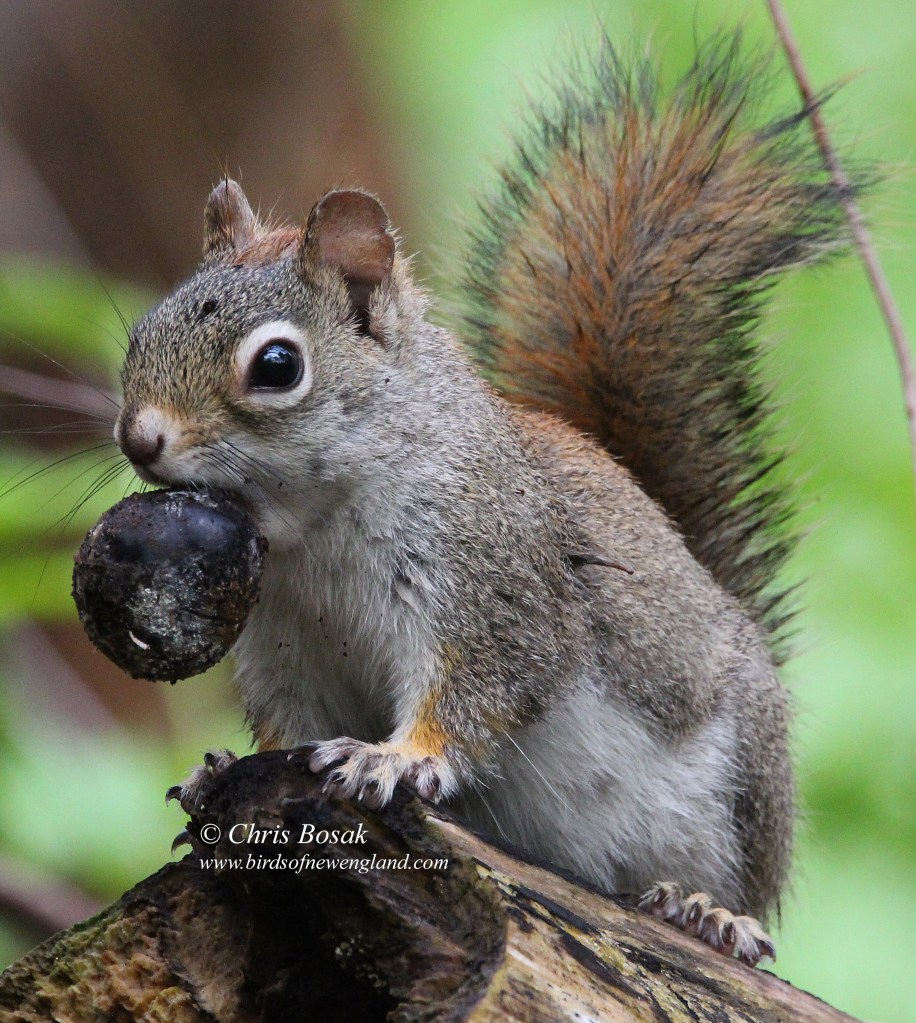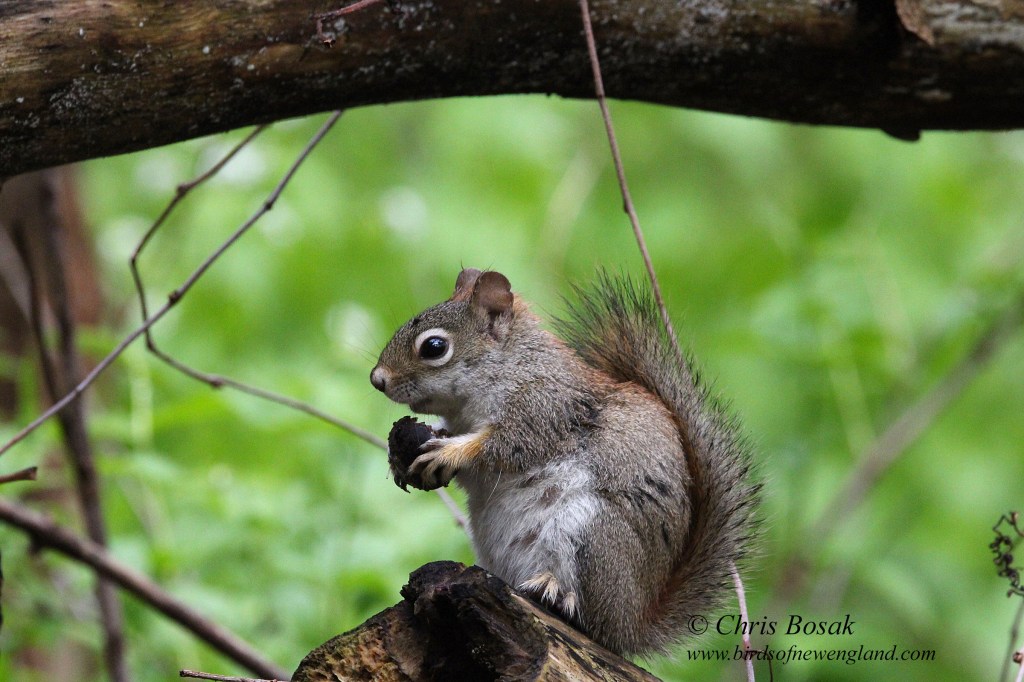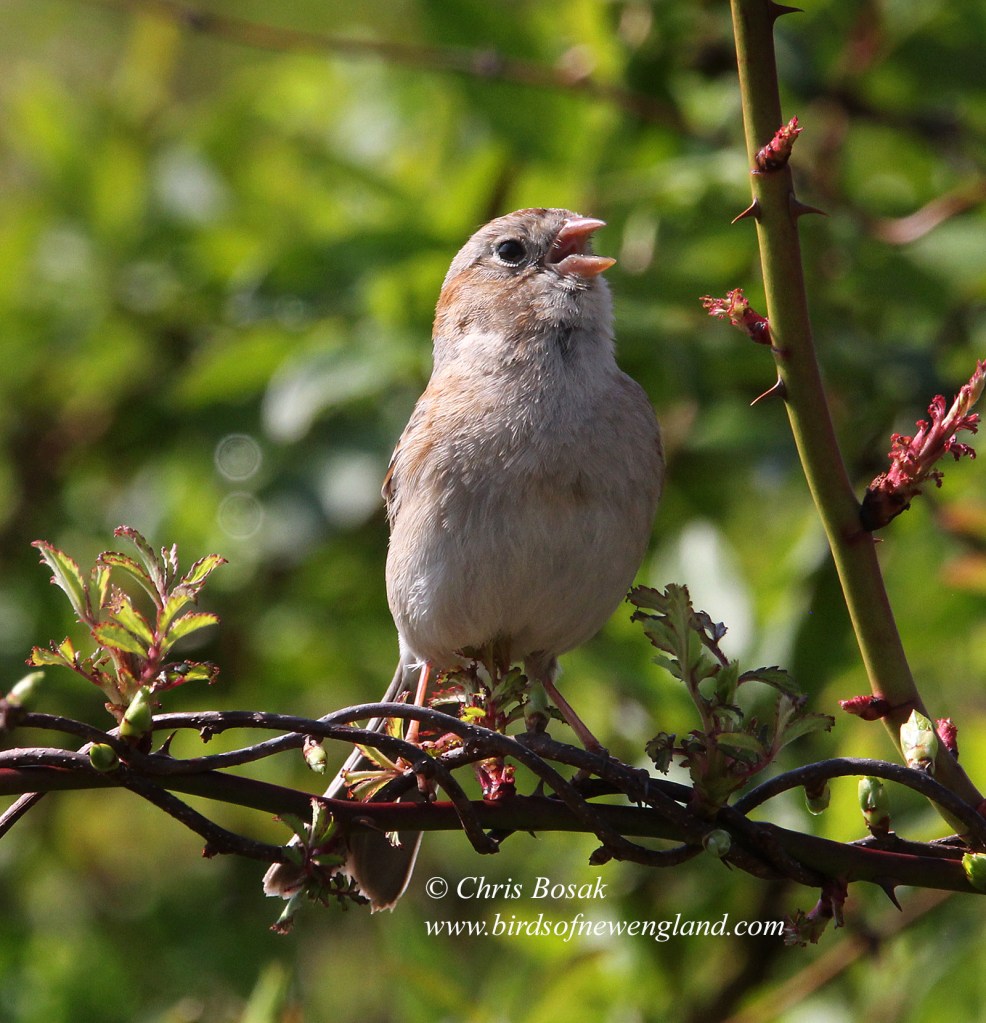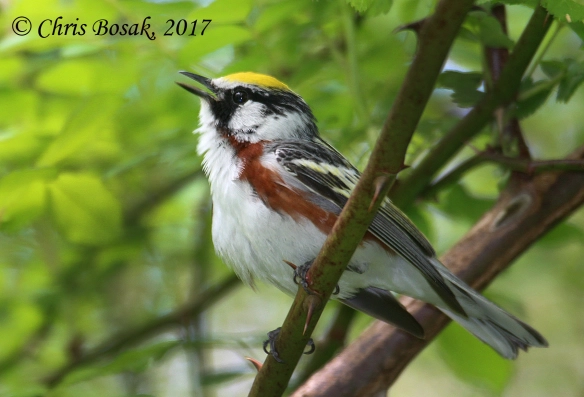
Here are a few more shots of the veery I encountered on a recent walk in New England. Here is the original For the Birds post.




Here are a few more shots of the veery I encountered on a recent walk in New England. Here is the original For the Birds post.



Visions of warblers, tanagers, orioles and grosbeaks may dance in the heads of birdwatchers in May, but the woods and fields are filled with a myriad of other types of birds as well.
While birds such as vireos and flycatchers continue to fascinate (and confuse) me, it has been thrushes that have captured a large portion of my attention so far this spring.
Wood thrushes in particular have been plentiful and conspicuous on my walks. By conspicuous, I mean I hear their flute-like songs several times as I wander through the woods. They can be amazingly difficult to find even as the song makes it seem like the bird is right in front of you. My actual find rate on wood thrushes is embarrassingly low — about on par with my batting average from my high school baseball days.
When I do find the bird, I can’t help but stand there and marvel at it. How can that awesomely musical song come from a relatively nondescript bird about seven inches long? Lang Elliot, who is well-known for his bird recordings, wrote: “The song of the wood thrush is undeniably one of the most beautiful of all forest melodies.”
Wood thrushes also have a distinctive call of repeated sharp notes that also echoes throughout the woods. The Cornell Lab of Ornithology describes it as “machine-gun-like alarm notes.” I hadn’t thought of that before, but it does make sense.
Wood thrushes are one of several members of the thrush family to grace New England’s woods. Most thrushes sport a distinctive brown body with spots on the chest. The shade of brown and the amount of spots on the chest vary from thrush to thrush.
The wood thrush is a rich brown with several distinctive spots that cover the chest and belly. The other thrushes — including hermit thrush, Swainson’s thrush, Bicknell’s thrush and veery — have lesser degrees of spotting with the veery having the least amount. Hermit, Swainson’s and Bicknell’s thrushes are very similar looking and often take an expert to tell them apart. Of those thrushes, the hermit thrush is the most common.
Ovenbirds and waterthrushes are similar in appearance to thrushes but are actually warblers. American robins and eastern bluebirds are indeed thrushes but do not resemble the aforementioned family members in appearance or song.
I was surprised during a walk the other day when I heard a thrush’s alarm call and turned to see a veery on the trail right behind me. I took a few photos of the bird before it hopped up onto a nearby branch and posed for a few more photos. Veeries have one of my favorite songs: a twirling melody that reminds me of the old Space Invaders game on Atari 2600. (Yes, I am that old.)
Early and mid May is always a whirlwind for birdwatchers. As soon as you get home from a walk, you’re ready for the next one and wondering what you’re missing by not being out there. The only thing you can do is be out there as much as possible. The season goes fast.

Birds aren’t the only animals you encounter during walks in the woods in New England. Squirrels, including red and gray, are a common “incidental” sightings.

Photo by Chris Bosak – A squirrel finds a meal in New England, May 2024.

Here are a few more shots of the Louisiana waterthrush I saw the other day. Waterthrushes look like thrushes and even have thrush in their name, but they are actually warblers.




Note: This article was originally published in early May and the story is based on a walk taken on April 29.
It was one of those “quick walks” that ended up being a three-hour birding journey.
I hit the trail shortly after sunrise and was immediately greeted by the awesome cacophony of bird sounds that can only happen during spring migration. The loud voices of cardinals, robins, and Carolina wrens were the dominant sounds. American crows cawed in the distance and red-winged blackbirds belted out their “conk-a-ree” songs from a nearby field. That was all good stuff, of course, but the real auditory treats came from birds with less conspicuous songs.
The softer calls of field sparrows and savannah sparrows emanated from the field, and a high-pitched, nearly inaudible, song came from the top of a maple tree near the parking lot.
It was a warbler, but which one? Since it was the beginning of spring migration and my warbler song identification skills are rusty, it took me a few seconds to realize it was a prairie warbler singing up there.
I hadn’t even gotten out of the parking lot yet, and my excitement for the walk grew. I took the immediate warbler sighting as a sign that the previous night had been a good one for migration, and it was going to be a bird-filled walk. Fast forward about three hours into my “quick walk,” and my gut feeling turned out to be right. It wasn’t necessarily a warbler-fest, but the variety of birds I saw made it one of those walks that I will remember for a long time.
Sparrows are quickly becoming one of my favorite bird families to watch and this walk featured several of these fascinating birds. White-throated sparrows remain the dominant species. I always enjoy seeing white-throated sparrows in the spring when they are in their bright, fresh breeding plumage. The white on their throats and heads and their yellow lores (area between bill and eye on side of head) really pop this time of year.
Field sparrows have a certain understated elegance about them as they are not flashy, but still attractive birds. Savannah sparrows, similar to white-throated sparrows, are particularly vibrant in the spring and the yellow stripes above their eyes really shine this time of year. Later in the walk, as I approached a pond and adjoining swamp, I noticed a shy swamp sparrow lurking in its namesake habitat. I also saw a chipping sparrow collecting straw for a nest during the walk.
I wrote a few weeks ago about the joys of spring vernal pools and highlighted the frogs and other such critters that may be found there. This walk took me past a shallow vernal pool that had two Louisiana waterthrushes bopping around looking for morsels to pull out of the muck. Louisiana waterthrushes are really warblers, even though they look like thrushes and don’t act like your “typical warbler.” They may be found on the ground near shallow pools or even streams scuttling around and making birders wonder whether they are looking at a Louisiana waterthrush or a northern waterthrush. Those species each migrate through New England and look nearly identical with a few subtle differences to tell them apart.
Some of the larger songbirds had returned overnight as well. I heard and then eventually spotted a Baltimore oriole among the treetops near the swamp. It always amazes me that a bird as big and bright as a Baltimore oriole could be so difficult to find among the leaves at the top of trees.
While on a trail with thick brush on either side, I heard the long, varying song of the rose-breasted grosbeak. That same trail also featured several blue-winged warblers. They gave away their whereabouts with their insect-like song before popping up out of the brush to offer a look at their yellow plumage and black, bandit-like eye stripe.
At the end of the walk, I had more than 40 species on my eBird list. It was a great day to kick off the full-blown spring migration period, and I look forward to more “quick walks” as the season progresses.

The Merlin app really came through this time.
I have written about the smartphone application that identifies birds by their songs and calls a few times before. I always stress, and I’m sure the app creators would agree, to confirm identifications by sight if you can find the bird.
The other day I was walking at a park, and the app showed that a brown thrasher was singing nearby. The app included a red dot by the species name, signifying that it is a rare bird to be seen where I was walking.
My immediate reaction, as a skeptic, was to not believe the app and assume it was a mockingbird instead. I have seen mockingbirds where I was walking several times. Brown thrashers are mimics like mockingbirds, so the misidentification would be understandable.
It took a minute or two to find the bird in question. Indeed, it was a brown thrasher. It was singing from the top of a deciduous tree that was starting to leaf out, which is why it took some time to find the bird. Usually, brown thrashers lurk in thick brush, but when they are singing, they often find a high perch.
After training my binoculars on the handsome bird, there was no question it was a brown thrasher. Its endless song continued as I stopped on the trail and watched and listened to the impressive songster.
The thrasher flew from treetop to treetop, never stopping its impressive singing. I recognized a few of the birds it was imitating, which is always fun to do with thrashers and mockingbirds.
Knowing the bird was a thrasher at this point, its song had a raspier quality to it than that of a mockingbird. Curious, I did an internet search when I got home on the differences between a mockingbird’s and brown thrasher’s song. It turns out, as similar as they are, there are some differences.
Cornell Lab of Ornithology’s website, All About Birds, includes the following about the brown thrasher’s song: “Brown Thrashers, like catbirds and mockingbirds, are mimics with extremely varied repertoires consisting of more than 1,100 song types. The male sings a loud, long series of doubled phrases with no definite beginning or end, described by some people as “plant a seed, plant a seed, bury it, bury it, cover it up, cover it up, let it grow, let it grow, pull it up, pull it up, eat it, eat it.” While mockingbirds tend to repeat phrases three or more times, Brown Thrashers typically sing phrases only twice before moving on. They include somewhat crude imitations of other species in their songs.”
I find it noteworthy that they say the mockingbird sings a phrase three or more times, while a brown thrasher repeats it twice. Also, who am I to disagree with the Cornell Lab of Ornithology, but I contest the notion that brown thrashers’ imitations are “somewhat crude.” They sound pretty darn good to me.
Knowing these differences will give me an advantage the next time I hear a mockingbird or thrasher singing nearby. Hopefully, I will retain the information and be able to tell which species is singing without the assistance of Merlin. Obviously, I do not want to come to rely on the app as I work on improving my birding-by-ear skills, but, in my opinion, for a machine to be able to differentiate by song a mockingbird from a brown thrasher is pretty impressive.

Judging from my own experience this morning and several posts on birding community websites, last night was a good night for migration with many of the long-awaited warblers and other songbirds arriving this morning. I had 43 species on my eBird list, including a few warblers, rose-breasted grosbeak, Louisiana waterthrush, Baltimore oriole, and American woodcock.
Here are a few shots from the day.





I saw a yellow-rumped warbler, a few pine warblers and several palm warblers on my last bird walk. That can only mean one thing: time for my annual spring warbler column.
The aforementioned warblers are the earliest to arrive in New England in the spring. The rest will follow shortly.
But first, what is a warbler? A warbler is a small Neotropical songbird. Many are colorful but not all of them. Yellow is a common color among warblers, but white, black, orange, brown and tan are also found frequently on warblers. While some spend their winters in the southern part of the U.S., most migrate farther to Central or South America, or the islands south of the U.S. A few stragglers may be spotted in New England during the winter, but it’s not common.
Warblers breed throughout the U.S., mostly in the northern states and into Canada. By late September and into October, warblers do their southward migration. In April and May, they pass through the area again — this time in their fresh spring plumage.
Many warblers will remain in New England to raise families, and others will head farther north. Yellow warblers and common yellowthroats, for me anyway, are the species most commonly seen during the summer raising their families. I’ve also found the breeding spots of American redstart, ovenbird, pine warbler and a few other species.
Warblers are best known in New England for their spring migration. In their best breeding plumage, dozens of species of warblers pass through New England in April and May with the peak being the first two weeks in May. This also coincides with the return of other colorful songbirds such as rose-breasted grosbeak, scarlet tanager, indigo bunting and Baltimore oriole.
Watching warblers can be incredibly rewarding and frustrating at the same time. With a few exceptions, warblers do not visit birdfeeders, meaning they must be found “in the wild.” Sometimes they are easy to find, but usually they are flitting among the leaves and hard to pinpoint. The typical size of a warbler is about five inches, so it’s not like trying to find a blue jay or robin.
Their songs are usually sung softly, so it takes a good ear to find them that way too. Also, there are dozens of warbler species and learning their songs, while infinitely valuable when in the field, is not the easiest task. Try the Merlin app to help identify warblers by song. Remember, though, while the app is extremely helpful and accurate, it is not 100 percent accurate. It’s best to “get eyes” on the birds in addition to having Merlin ID it by sound.
Some of the most common species to look for include the yellow warbler, yellow-rumped warbler, American redstart, common yellowthroat, northern parula, chestnut-sided warbler, blue-winged warbler, black-and-white warbler, black-throated green warbler, black-throated blue warbler and magnolia warbler. Ovenbirds, whose loud “teacher, teacher, teacher” song if often heard in the New England woods in the spring, are also warblers.
As I mentioned, there are dozens of other warbler species that pass through or breed in New England. A good field guide, whether an app on a smartphone or an old-fashioned paper book, is a must for identifying warblers. I wish I could describe each warbler in detail here, but obviously, that’s not feasible.
The spring warbler migration is a highlight of the year for many birdwatchers, myself included. There will be a dizzying assortment of birds to find in the coming weeks. Let me know your highlights.